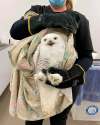Roadway rescue leads to live coyote inside car
Advertisement
Read this article for free:
or
Already have an account? Log in here »
To continue reading, please subscribe:
Monthly Digital Subscription
$0 for the first 4 weeks*
- Enjoy unlimited reading on winnipegfreepress.com
- Read the E-Edition, our digital replica newspaper
- Access News Break, our award-winning app
- Play interactive puzzles
*No charge for 4 weeks then price increases to the regular rate of $19.00 plus GST every four weeks. Offer available to new and qualified returning subscribers only. Cancel any time.
Monthly Digital Subscription
$4.75/week*
- Enjoy unlimited reading on winnipegfreepress.com
- Read the E-Edition, our digital replica newspaper
- Access News Break, our award-winning app
- Play interactive puzzles
*Billed as $19 plus GST every four weeks. Cancel any time.
To continue reading, please subscribe:
Add Free Press access to your Brandon Sun subscription for only an additional
$1 for the first 4 weeks*
*Your next subscription payment will increase by $1.00 and you will be charged $16.99 plus GST for four weeks. After four weeks, your payment will increase to $23.99 plus GST every four weeks.
Read unlimited articles for free today:
or
Already have an account? Log in here »
Hey there, time traveller!
This article was published 02/12/2019 (2195 days ago), so information in it may no longer be current.
Animal rescuers are warning Manitobans to contact experts to deal with injured wildlife, advice that comes after a motorist rescued an unconscious animal and then had the coyote awaken in his car.
Eli Boroditsky, 68, was driving to work shortly before 10 p.m. on Nov. 26 when a large animal unexpectedly jumped onto the road in front of him.
“I thought it was a domesticated animal. I thought it was a dog, just a large dog. That’s why I tried to take it with and keep an eye on it so that it could be looked after,” said Boroditsky, nearly one week after the incident.

After the collision at 90 km/h, he parked his car, checked on the injured animal on the highway’s shoulder and decided to put the groggy creature in the back of his vehicle.
“I was just concerned that if I left it there, a wild animal might come by and kill it,” he said, adding he had to work a late shift at Bothwell Cheese in New Bothwell, Man., about 40 kilometres southeast of Winnipeg.
He then drove to work with the animal on the floor in the back of his car. When he arrived, he told a coworker, who went out to his car and identified the animal as a coyote — a discovery that Boroditsky said shocked him.
The duo was unable to contact a conservation officer for help until the next morning. Before then, the coyote had awoken and was lying down on the backseat of the car.
“It was extremely docile. It was injured, it wasn’t severely injured, but she was awake and just laid there,” Boroditsky recalls.
He said the animal did not urinate, defecate or scratch up the seats of his car. The only damage his car sustained was from hitting the animal initially.
The next morning, a provincial conservation officer transported the coyote to the Wildlife Haven Rehabilitation Centre in Île-des-Chênes, where she is expected to make a full recovery.
“We’re very happy that conservation officers were called because this could’ve been a pretty dangerous situation. With animals and predators, it can be dangerous to have them in your car,” said Zoe Nakata, executive director at the centre.
Nakata said coyotes can be identified by their long snouts and puffy tails. If unsure about an injured animal’s identity or for any advice, she encourages all Manitobans to call her centre, others like it or a provincial conservation officer.
A Manitoba Conservation spokesperson also said in a statement Monday the department agrees Manitobans should not put wildlife in their cars.
As for the recovering coyote, Nakata said it suffered head trauma and wounds on her face and leg, but she’s on the mend.
The coyote is the centre’s 2,100th patient this year. Nakata said the centre has taken in a record number of animals in 2019 — up from 1,900 last year and about 1,750 two years ago.
The average animal rehabilitation case costs the centre, which is funded by community donations, a total of $500.
maggie.macintosh@freepress.mb.ca
Twitter: @macintoshmaggie

Maggie Macintosh
Education reporter
Maggie Macintosh reports on education for the Free Press. Originally from Hamilton, Ont., she first reported for the Free Press in 2017. Read more about Maggie.
Funding for the Free Press education reporter comes from the Government of Canada through the Local Journalism Initiative.
Every piece of reporting Maggie produces is reviewed by an editing team before it is posted online or published in print — part of the Free Press‘s tradition, since 1872, of producing reliable independent journalism. Read more about Free Press’s history and mandate, and learn how our newsroom operates.
Our newsroom depends on a growing audience of readers to power our journalism. If you are not a paid reader, please consider becoming a subscriber.
Our newsroom depends on its audience of readers to power our journalism. Thank you for your support.


